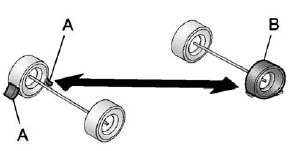If a Tire Goes Flat
It is unusual for a tire to blowout while driving, especially if the tires are maintained properly. If air goes out of a tire, it is much more likely to leak out slowly. But if there ever is a blowout, here are a few tips about what to expect and what to do:
If a front tire fails, the flat tire creates a drag that pulls the vehicle toward that side. Take your foot off the accelerator pedal and grip the steering wheel firmly. Steer to maintain lane position, and then gently brake to a stop, well off the road, if possible.
A rear blowout, particularly on a curve, acts much like a skid and may require the same correction as used in a skid. Stop pressing the accelerator pedal and steer to straighten the vehicle. It may be very bumpy and noisy. Gently brake to a stop, well off the road, if possible.
WARNING
Driving on a flat tire will cause permanent damage to the tire.
Re-inflating a tire after it has been driven on while severely underinflated or flat may cause a blowout and a serious crash.
Never attempt to re-inflate a tire that has been driven on while severely underinflated or flat.
Have your dealer or an authorized tire service center repair or replace the flat tire as soon as possible.
WARNING
Lifting a vehicle and getting under it to do maintenance or repairs is dangerous without the appropriate safety equipment and training. If a jack is provided with the vehicle, it is designed only for changing a flat tire. If it is used for anything else, you or others could be badly injured or killed if the vehicle slips off the jack. If a jack is provided with the vehicle, only use it for changing a flat tire.
If a tire goes flat, avoid further tire and wheel damage by driving slowly to a level place, well off the road, if possible. Turn on the hazard warning flashers. See Hazard Warning Flashers on page 6‑5.
WARNING
Changing a tire can be dangerous. The vehicle can slip off the jack and roll over or fall causing injury or death. Find a level place to change the tire. To help prevent the vehicle from moving:
1. Set the parking brake firmly.
2. Put an automatic transmission in P (Park) or a manual transmission in 1 (First) or R (Reverse).
3. For four-wheel-drive vehicles, be sure the transfer case is in a drive gear – not in N (Neutral).
4. Turn off the engine and do not restart while the vehicle is raised.
5. Do not allow passengers to remain in the vehicle.
6. Place wheel blocks on both sides of the tire at the opposite corner of the tire being changed.
When the vehicle has a flat tire (B), use the following example as a guide to assist in the placement of the wheel blocks (A).
 A. Wheel Block
A. Wheel Block
B. Flat Tire
The following information explains how to use the jack and change a tire.
See also:
Exterior
The Canyon is saddled with an angular headlight brow, borrowed from the
Colorado, that forces a more trapezoidal execution of the grille than do
standard GMC truckfront ends. Other GMC trucks, inc ...
Vehicle Messages
Messages displayed on the DIC indicate the status of the vehicle or some action may be needed to correct a condition. Multiple messages may appear one after another.
The messages that do not require ...
Interior
Manual inside rearview mirrors can be adjusted by holding in the center to move
the mirror for a clearer view of behind the vehicle. Adjust the mirror to avoid
glare from the headlamps behind you. ...





